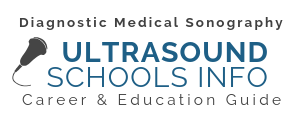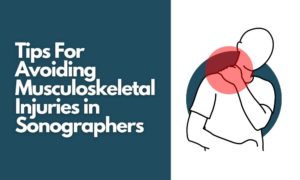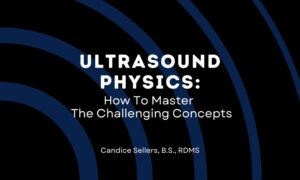According to the SDMS, 90% of sonographers will sustain a work related musculoskeletal disorder; 20% will have a career ended because of the injury.
With numbers this high it seems like it’s an inescapable truth that you must scan in pain or get injured at some point, but that doesn’t have to be the case! I’ve spoken to sonographers who are 5 surgeries deep and others who have scanned for 17 years and never felt pain. What is the difference? There are a few steps you can take to have better ergonomics to help scanning be pain free for your whole career.
Reduce Injury With Proper Patient Positioning
Properly positioning the patient is the first place to start. The table should be raised to your elbow height. In patients with a higher BMI, it is more comfortable to have the table a little lower so you are not pushing upwards.
Whenever possible have the patient help you by moving closer on the bed to you. The more you can keep your scanning arm close to your body the less strain it will be. I found the biggest source of pain is when the patient is not far from me but forward from where I am. Meaning if my scanning arm has to reach out to the front and apply pressure it causes a significant shoulder pain. Move the bed down to be next to you or your machine more toward the patient’s head to minimize this forward pressure. Patient’s condition of being able to roll and not have you reach forward or sideways also will help minimize scanning injury.
Ready, Set, Stretch! Incorporate these stretches into your daily routing to help avoid injury.
Most Common Injuries in Sonographers
Wrist fatigue and pain
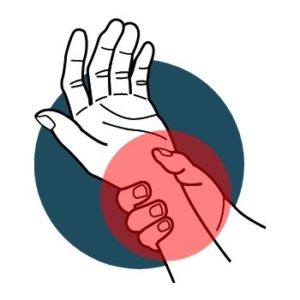 Carpal tunnel and other hand injuries are common, which isn’t so surprising since we are gripping the ultrasound camera and pushing as hard as we can into patients. I sometimes find myself holding the camera like a toddler to get better pictures using a two finger hold for better fine motor movement. And sure enough it will hurt after. But gripping the probe with the fleshy part of your hand between the thumb and pointer finger and using that more muscular part to push can lower the pressure on your wrist and hand.
Carpal tunnel and other hand injuries are common, which isn’t so surprising since we are gripping the ultrasound camera and pushing as hard as we can into patients. I sometimes find myself holding the camera like a toddler to get better pictures using a two finger hold for better fine motor movement. And sure enough it will hurt after. But gripping the probe with the fleshy part of your hand between the thumb and pointer finger and using that more muscular part to push can lower the pressure on your wrist and hand.
Use all your fingers to hold the camera and relax the wrist. No lobster claw holds! It may also be tempting to twist your wrist into unnatural positions but the more natural you can hold it the better. That scanning hand is important so try and protect it as much as possible! A wrist brace may help hold the wrist and give an extra layer of support.
Elbow Strain
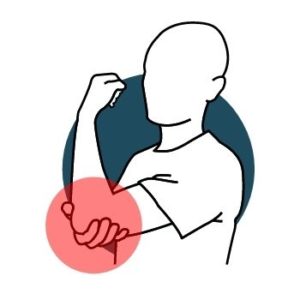 As discussed earlier this can be a hinge point to press into your patients so correct height is important. Many sonographers suggest sitting while scanning and resting the elbow on an armrest to help support it. I find a cable strap attached to my forearm can hold the cord for the camera and reduce
As discussed earlier this can be a hinge point to press into your patients so correct height is important. Many sonographers suggest sitting while scanning and resting the elbow on an armrest to help support it. I find a cable strap attached to my forearm can hold the cord for the camera and reduce
torque and pressure coming from a dangling cord.
Shoulder pain
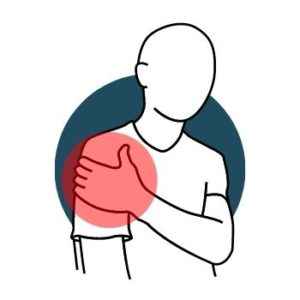 This is usually where I am guilty of feeling pain. It’s difficult to not compensate for pressure from the shoulder. When in doubt, keep that arm in as close to your side as possible and don’t reach out laterally or forward. Sometimes I end up sitting on the bed with an immobile patient, so maybe bring an extra towel or sheet on portable exams to give yourself something to lean on. This is kind to your patient too who probably didn’t expect to see a sonographer laying in their bed that day!
This is usually where I am guilty of feeling pain. It’s difficult to not compensate for pressure from the shoulder. When in doubt, keep that arm in as close to your side as possible and don’t reach out laterally or forward. Sometimes I end up sitting on the bed with an immobile patient, so maybe bring an extra towel or sheet on portable exams to give yourself something to lean on. This is kind to your patient too who probably didn’t expect to see a sonographer laying in their bed that day!
Aching Back
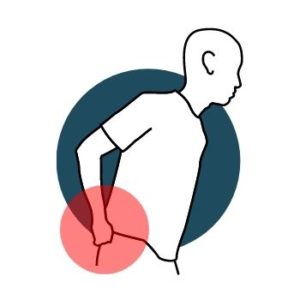 While scanning it may be tempting to lean to the side and have your back drape laterally, to get closer to your patient. It is best to think of all the bones in your spine and imagine stacking them one on top of the other. This will help other possible injuries to hips and legs as well.
While scanning it may be tempting to lean to the side and have your back drape laterally, to get closer to your patient. It is best to think of all the bones in your spine and imagine stacking them one on top of the other. This will help other possible injuries to hips and legs as well.
What has made the biggest difference to my pain levels has been assuming a proper scanning position and then after work going to exercise. A good stretch and muscle building routine will be vital to staying well for your career. Many sonographers also opt for monthly massages to help loosen those trouble
spots.
While scanning, check in with your body and don’t get so focused you don’t realize that something is getting stressed. If you feel pain, fix it! Take a quick break and stretch or move the muscle in a different way to loosen it. My favorite thing is taking a moment, shaking the gel bottle and then refocusing for another go. Change up your position or the patient’s to make things more comfortable.
In the end, we push ourselves to get the best picture possible and do the best for the patient diagnosis. Unfortunately, for some body habitus ultrasound is not the optimal choice for imaging and that’s not a the fault of a sonographers’ skill level. It could be gas or just inability to penetrate the tissues adequately. Do your best and try to see what is possible but don’t injure yourself for something that is impossible. Think of all the patients that won’t have a diagnosis if you are unable to scan. Take care of yourself and happy, healthy scanning!
Related Interview – Sonographer, Educator, Pioneer and Ergonomics Expert, Joan P. Baker
If you’d like to learn more about opportunities in sonography, check out some of our other inspiring interviews and articles:
- Anatomy & Physiology: A Student’s Perspective – Is an Anatomy & Physiology class in your future? Here’s some real life advice, from a fellow student who’s been there.
- An Interview With Sonographer Dr. Traci Fox EdD, RT(R), RDMS, RVT
- Why I Chose Diagnostic Medical Sonography – Join Sonography Student & Contributor Lynn on her journey as she pursues a 2nd career as a sonographer.
